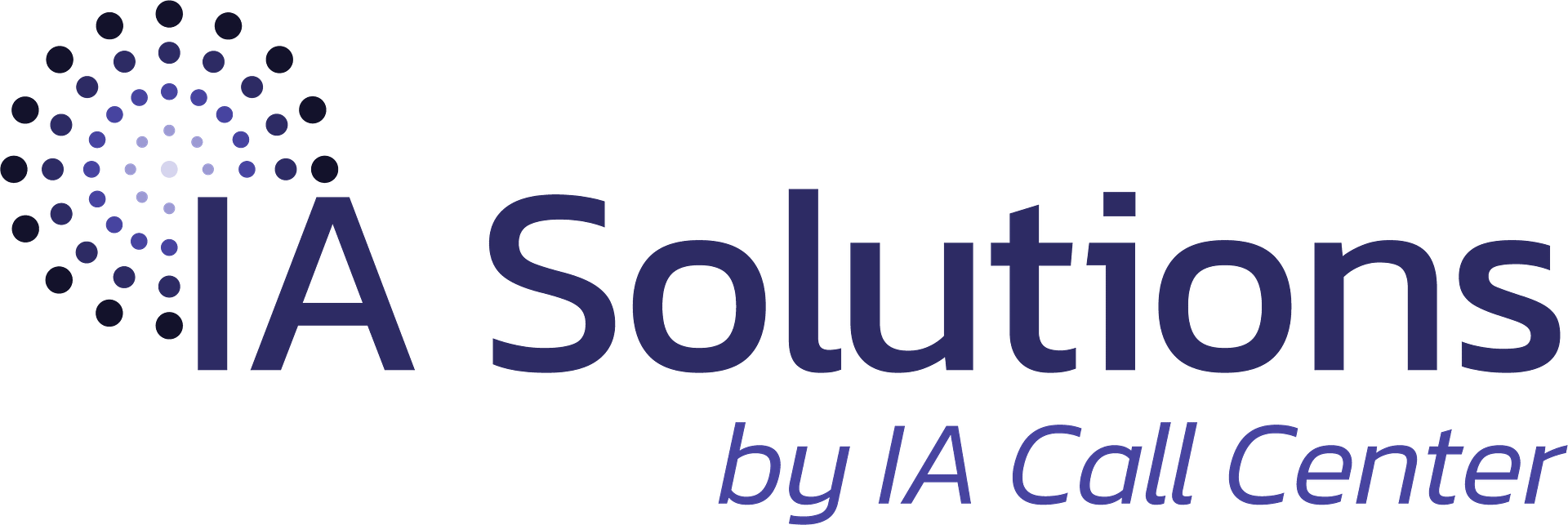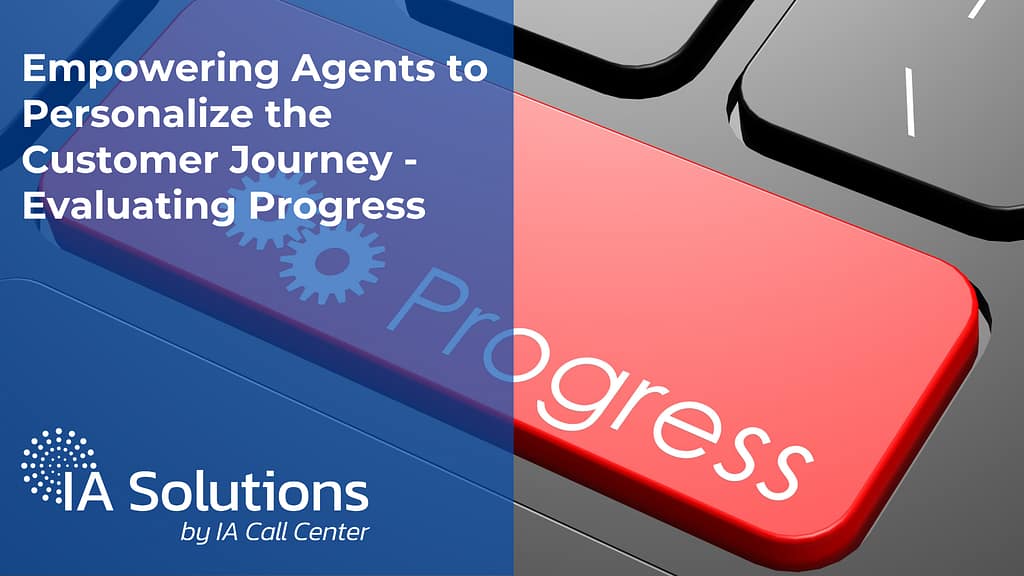Empowering Agents to Personalize the Customer Journey – Evaluating Progress
Rather listen to the audio for this post instead? Click the play button below to hear it now.
(Note – This is the seventh post in our 10-part series, “Empowering Agents to Personalize the Customer Journey.” If you missed the last one, “Agent Autonomy,” please click here to view it now. We will release new posts for this series every week. Therefore, please be sure to enable notifications to receive updates when we post new articles.)
Introduction
With today’s high-speed business landscape, creating a personalized customer journey is key to delivering excellent customer service. An omnichannel approach to customer engagement allows your agents to provide an uninterrupted customer experience across all touchpoints. By utilizing an omnichannel approach, agents can deliver customer experiences tailored to each customer by leveraging data and insights from customer interactions.
Implementing an omnichannel approach to customer engagement alone is not enough, though. It’s also important for your business to analyze regularly the effectiveness and progress of the implementation to know what is working, what isn’t, and how to make progress. This article examines how you can measure your omnichannel implementation and what elements to consider for personalizing the customer journey and judging improvement effectively.
The Importance of Personalizing the Customer Journey
More than ever, it is now necessary for companies to tailor the customer journey to match varying customer behaviors and desires. It is possible to tailor interactions with customers to meet their individual needs and preferences through personalization. Your business can succeed in this endeavor by utilizing a variety of techniques, including targeted marketing blueprints, individualized product recommendations, and personalized customer service.
Here are a few of the key reasons personalizing the customer journey is essential for businesses:
Improved Customer Experience
Personalizing the customer journey helps your business deliver exceptional customer experiences. When your customers feel that their needs and preferences are being understood and catered to, they are more likely to be satisfied with their overall experiences. Of course, this leads to increased loyalty and repeat business.

Increased Customer Retention
Tailoring customer experiences can help your business maintain customer loyalty. Showing customers you value them and recognize their needs will help keep them loyal to your business. This can result in customers who come back again and again, as well as positive word-of-mouth recommendations.
Higher Conversion Rates
Personalization can also lead to higher conversion rates. Providing your customers with individualized product suggestions or targeting them with specific marketing campaigns will likely result in increased sales. This is because the products or services being offered are more relevant and tailored to their specific needs.
Improved Customer Insights
By personalizing experiences, you gain valuable clues to customer behavior and tastes. Examining data on customer interactions and behaviors can help your company gain a better insight into their customer’s desires and needs. Subsequently, your company can use this data to shape future marketing strategies, product design, and business objectives.
Competitive Advantage
Personalizing services can help your business stand out in an ultra-competitive landscape. Offering a one-of-a-kind experience helps your company differentiate itself from the competition and also aids in attracting and keeping customers. This could, of course, result in greater market share for your company and higher profit margins.
Key Metrics to Evaluate Your Omnichannel Implementation
In order to measure the success of your omnichannel implementation, you must pay attention to particular metrics that give you insight into the customer experience. Here are some important measurements that you should monitor to measure the success of your omnichannel plan:
Customer Satisfaction Score (CSAT)
The CSAT is a way of gauging how pleased customers are with the service they receive. With this metric, a survey question is usually used to measure customer satisfaction, which asks customers to rate their satisfaction with a certain interaction or experience. Monitoring CSAT ratings at all points of engagement will give you better insight into how customers feel about your service.
Say, for instance, a customer buys something on your website and rates their satisfaction with the shopping experience from 1 to 10. The customer’s CSAT score of 8 implies that they are pleased with their experience, but they still see areas that may need improvement.
A survey by SuperOffice says that the average CSAT rating among different industries is 8.6 (or 86%), suggesting that customers are generally content with the service they receive. Nevertheless, the survey determined the average CSAT score for virtual sellers was lower, at 83%. This suggests that online vendors may need to concentrate more on offering a personalized customer journey to raise their CSAT scores.

Net Promoter Score (NPS)
The NPS is a way to figure out how devoted customers are to your product or service and the likelihood of them recommending it to other people. You measure NPS using a one-question survey, which requests that your customers rate their likelihood to recommend your product or service on a scale from 0 to 10. Analyzing NPS scores from different sources of customer interaction can shed light on customer loyalty and advocacy.
To illustrate, a customer completes an order on your website and gauges their likelihood to suggest your business to a friend or colleague on a scale of 0 to 10. Customers who give a score of 9 or 10 on the NPS are seen as promoters and usually will recommend your business to others. Of course, customers who promote your business are the ideal kind to have.
A Salesforce survey showed that the average NPS score for all industries was 3.2. This suggests that there is much room for improvement in terms of customer loyalty and advocacy across industries. As such, increasing your NPS score should be a top priority, as word-of-mouth referrals remain (even in this digital age) the most powerful form of advertisement or promotion.
First Contact Resolution (FCR)
The FCR metric measures the percentage of customer inquiries resolved on the first contact with your customer service team. A high FCR rate shows that agents are doing a good job of resolving customer issues the first time they contact your business, which always leads to higher customer satisfaction.
Let’s say, for instance, a customer reaches out to your contact center to inquire about one of your products or services, and the agent is able to provide the necessary information without transferring the call or escalating it to a supervisor or manager. This is likely to lead to a high first contact resolution (FCR) rate, which suggests that your agents are dealing with most customer queries successfully on the first attempt.
CallMiner’s research suggests that the average FCR rate across all industries is about 70%. This implies that there is still plenty of room for improvement in terms of resolving customer inquiries during the initial contact.
Average Handle Time (AHT)
The AHT metric is a measure of the average time taken by an agent to handle a customer inquiry or interaction. When the Average Handling Time is low, it shows that agents are proficient in addressing customer queries, resulting in increased customer satisfaction.
For example, a customer calls your contact center with a query and the agent responds promptly with the necessary information. An AHT that is low demonstrates that agents are able to manage customer questions efficiently.
According to a study by CallCentreHelper, the average AHT across industries is about 6 minutes. This suggests that there might be room for improvement in terms of reducing AHT to improve agent efficiency and customer satisfaction.
Customer Effort Score (CES)
The CES metric determines the convenience of a customer’s experience with a company, product, or service. Businesses normally gauge the experience using a poll that requests customers to rate the simplicity of their experience from 1 to 5. Monitoring CES scores from different points of contact will give you an idea of how much effort customers are putting into connecting with your business.
For instance, a customer calls your contact center with a question and is satisfied enough to rate the experience as 4 out of 5. This shows the customer thought the experience was fairly straightforward, but they feel there’s room for improvement.
According to several contact-center industry studies, the average CES score across industries is about 4 out of 5. This suggests that there is room for improvement in terms of reducing customer effort to improve their experience.

Steps to Evaluate Your Omnichannel Progress
To evaluate the effectiveness of your omnichannel implementation, you need to follow specific steps that will help your business identify areas that need improvement. Below are the steps that your business should follow to evaluate your omnichannel implementation:
Define Goals and Objectives
Start by defining your goals and objectives. What do you want to achieve with your omnichannel implementation? What metrics will you use to measure success? By defining your goals and objectives upfront, you will have a clear roadmap of what you want to achieve.
For example, your goals may include improving your CSAT score by 5%, reducing your AHT by 2 minutes, and increasing your NPS score by 10 points. You may also use metrics such as FCR and CES to track progress towards these goals.
Analyze Baseline Metrics
Next, analyze your baseline metrics to establish a benchmark. What are your numbers for customer satisfaction, net promoter score, first contact resolution, average handle time, and customer effort score? Setting a benchmark will give you a reference point from which to measure development.
To provide an example, your CSAT might be 85%, NPS 30, FCR 65%, AHT 7 minutes, and CES 3.5 out of 5.
Identify Areas for Improvement
Analyze your current metric scores and decide what needs to be improved. What measurements require improvement, and how can your team do better? For example, if your CSAT results are low due to long wait times, you could introduce changes like employing more agents, upgrading your IVR system, or providing self-service options to reduce wait times.
Implement Changes
Locate the areas that need improvement and then take measures to correct them. To illustrate, if your AHT is high, you might need to create training programs to assist agents in dealing with customer inquiries more proficiently. Your business might also consider using tools like chatbots or AI-powered virtual assistants that can manage repetitive inquiries and tasks, which gives agents chances to tackle more complex inquiries.
Measure Results
Next, measure the results of any changes you make. Are your CSAT, NPS, FCR, AHT, and CES scores improving? Are you meeting your goals and objectives? Examining the results of your changes can show you if your omnichannel implementation is becoming more successful.
To illustrate, after instituting modifications to cut wait times, your CSAT ratings might climb to 90%, and your AHT may drop to 5 minutes. Similarly, if you introduce effective training programs, it may result in an FCR rate increase to 80%, suggesting that agents are better able to resolve customer concerns during initial contact with customers.
It may also be helpful to consider granting your agents more autonomy to enhance scores and customer experiences. Agents with the autonomy or authority to make decisions on their own can take ownership of their interactions and usually provide better customer experiences.

Continuously Adapt
Always keep in mind that customer requirements and expectations are always changing. It is therefore important to adjust continually to satisfy your customers’ evolving needs. Check your metrics often, recognize what needs to be improved, and put changes in place to address any issues.
Finally, review and evaluate the phrasing and scripts used by your agents to ensure they resonate well with customers and align with your company’s brand and values. By continuously adapting, you can ensure that you are delivering exceptional customer service that meets your customers’ needs.
Summary
Delivering personalized experiences results in happier, more loyal customers, as well as word-of-mouth advertising. Therefore, it is necessary to evaluate and improve your omnichannel services on a regular basis to ensure that your business is offering the best customer service possible.
In this article, we discussed the importance of personalizing the customer journey and explored primary metrics such as CSAT, NPS, FCR, AHT, and CES (which your company should track to evaluate the effectiveness of its omnichannel approach.) This post also outlines the steps your company should follow to evaluate your omnichannel implementation, such as defining goals and objectives, analyzing baseline metrics, identifying areas for improvement, implementing changes, measuring results, and adapting to meet customer needs and expectations.
By tracking important metrics and following the steps described in this article, your business can review and improve its omnichannel processes continually, ensuring that your agents are delivering better customer experiences that drive business success.
In the next post of our Empowering Agents to Personalize the Customer Journey series, we will discuss refining processes in your omnichannel implementation (after using this article to evaluate them, of course.) If you want to learn more about how refining your omnichannel services can help your agents to better personalize the customer journey, be sure to check back a few days after this post.















